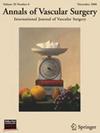超越血管内解决方案:针对主动脉瓣置换术(EVAR)后持续性主动脉腔扩张的开放式腔隙翻修术与移植物保留。
IF 1.4
4区 医学
Q3 PERIPHERAL VASCULAR DISEASE
引用次数: 0
摘要
背景:血管内动脉瘤修复(EVAR)后主动脉囊扩张与更高的再干预率、晚期破裂和长期全因死亡率相关。血管内选择有局限性,如果失败,指南建议开放手术翻修(OSR)。本研究回顾了奥克兰市医院EVAR后OSR的技术、适应症和结果。方法:我们选取了2010年1月至2023年10月在奥克兰市医院进行evar后主动脉囊扩张的所有OSR病例。技术包括囊闭合、应用或网膜包裹。排除移植物感染的病例。结果:17例患者(中位年龄:82岁,主要为男性)接受了OSR,中位随访时间为3年。88.24%的患者主要指征为囊腔扩张伴2型内漏(T2EL), 2例为V型内漏。术中有94.12%的患者出现肠内漏,其中T2EL占88.24%,3型肠内漏占17.65%。58.82%的病例行网膜成形术。虽然没有统计学上的显著性,但与囊闭合相比,网膜成形术的内漏复发率更低。17.65%的患者(3/17)需要再次干预进行性囊扩张,另外2例患者(11.76%)因复发性囊漏而无需进一步干预。所有患者均出院,82.35%的患者无需康复即可回家。中位住院时间为7天,30天死亡率为0%。结论:OSR结合移植物保存是evar后囊扩张的有效方法,有助于识别和修复内漏,同时避免了主动脉夹持。持续的监测是必要的。本文章由计算机程序翻译,如有差异,请以英文原文为准。
Beyond Endovascular Solutions: Open Sac Revision with Graft Preservation for Persistent Aortic Sac Expansion Post-EVAR
Background
Aortic sac expansion after endovascular aortic aneurysm repair (EVAR) is associated with higher reintervention rates, late rupture, and long-term all-cause mortality. Endovascular options have limitations, and guidelines recommend open sac revision (OSR) if these fail. This study reviews the technique, indications, and outcomes for OSR following EVAR at Auckland City Hospital.
Methods
We identified all OSR cases with stent-graft preservation for aortic sac expansion post-EVAR at Auckland City Hospital from January 2010 to October 2023. Techniques included sac closure, plication, or omental wrapping. Cases involving infected grafts were excluded.
Results
Seventeen patients (median age: 82 years, predominantly male) underwent OSR, with a median follow-up of 3 years. The primary indication was sac expansion with type 2 endoleak in 88.24% of patients, while 2 cases were type V endoleaks. Intraoperatively, endoleaks were found in 94.12% of patients, with 88.24% having type 2 endoleak and 17.65% having type 3 endoleaks. Omentoplasty was performed in 58.82% of cases. Although not statistically significant, there was a trend toward lower endoleak recurrence with omentoplasty than sac closure. Reintervention for progressive sac expansion was required in 17.65% of patients (3/17), with 2 additional patients (11.76%) monitored for recurrent endoleak without further intervention. All patients were discharged, with 82.35% going home without needing rehabilitation. The median hospital stay was 7 days, and the 30-day mortality rate was 0%.
Conclusion
OSR with graft preservation is effective for sac expansion post-EVAR, facilitating endoleak identification and repair while avoiding aortic clamping. Ongoing surveillance is necessary.
求助全文
通过发布文献求助,成功后即可免费获取论文全文。
去求助
来源期刊
CiteScore
3.00
自引率
13.30%
发文量
603
审稿时长
50 days
期刊介绍:
Annals of Vascular Surgery, published eight times a year, invites original manuscripts reporting clinical and experimental work in vascular surgery for peer review. Articles may be submitted for the following sections of the journal:
Clinical Research (reports of clinical series, new drug or medical device trials)
Basic Science Research (new investigations, experimental work)
Case Reports (reports on a limited series of patients)
General Reviews (scholarly review of the existing literature on a relevant topic)
Developments in Endovascular and Endoscopic Surgery
Selected Techniques (technical maneuvers)
Historical Notes (interesting vignettes from the early days of vascular surgery)
Editorials/Correspondence

 求助内容:
求助内容: 应助结果提醒方式:
应助结果提醒方式:


